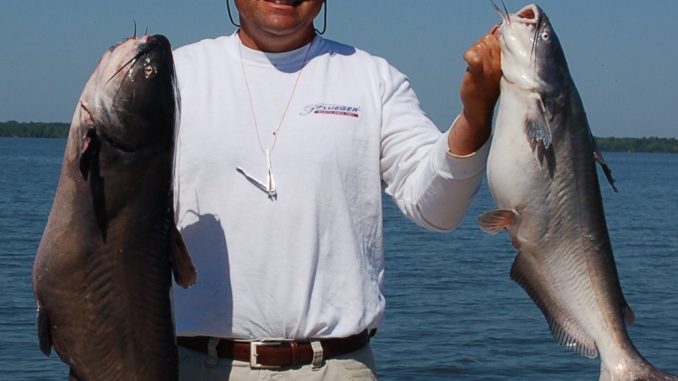
Find the shallow flats that are holding catfish on Lake Moultrie and Lake Marion and fill your cooler this month.
Fishermen come from all over to visit the Santee Cooper lakes every year, many to target the great numbers of catfish and the possibility of catching a trophy. And with fish shallow and spawning, spring is a perfect storm for the jumbo whisker lover.
Lake Moultrie and Lake Marion are recognized as two of the best lakes in the country to catch catfish, and for good reason. The 177,000 acres of flooded wilderness provides ideal habitat for catfish and the baitfish that feed them, chocked full of propeller-wrenching, century-old stumps, cypress trees and a garden of submerged aquatic vegetation.
Off all species, it can be argued that catfish are adaptable enough to live in almost any submerged habitat the lakes have to offer. But fishermen are in luck this month when almost the entire whiskered convoy confines itself to the shallow districts to conduct their mating rituals.
Finding those spawning areas is the key for the first step in planning a big catfish fry. Guide Kevin Davis of Black’s Camp said the different species of catfish in the two Santee Cooper lakes head shallow at different times as the temperatures rise.
“Catfish go shallow in big groups during the spring to find warm water,” said Davis. “It is also when and where our catfish begin spawning.”
Flathead catfish will head for the spawning grounds with the water temperature as cool as 67 degrees. Blue catfish and channel catfish require water in the low-70s up to the low-80s to spawn. It’s not uncommon for all three species be shallow at the same time, but flatheads will generally be the first to move up.
“I look for depressions on flats where there is water from 2 to 7 feet deep and where there is submerged structure,” Davis said. “Most of the depressions will have some vegetation holding food that the catfish will feed on during the day.”
The spring warm-up also pulls baitfish and all kinds of aquatic life into the shallows. While the shallow waters provide good places for catfish to spawn, there is plenty of food available: snails, baitfish and exotic mollusks, including massive populations of corbicula, aka asiatic clams.
“Our catfish feast on corbicula year-around. They consume handfuls of clams in one gulp,” said Davis, who has found the stomachs of many of the big catfish he catches brimming full of the hard-shelled mollusks.
According to Jimmy Holbrook, a catfish aficionado from Georgia who is a member of the Carolina Catfish Club, the clam beds scattered all over the shallows in Lake Marion and Lake Moultrie are superior places to find monster-sized catfish in the spring.
“I catch a lot of 40-pound-plus catfish in shallow water on clam beds,” said Holbrook, a past winner of a Cabela’s King Cat fishing tournaments on Santee Cooper whose forte is catching big cats.
Holbrook spends most of his time in the spring fishing shallow water because he believes there are many more fish and bigger fish shallow than deep at this time of year.
“I like places where creek channels lead up into the shallow water or creek arms that come up close to shallow flats that are littered with clams,” said Holbrook. “They travel up the channels from deep water and then slip up onto the flats to feed at night.”
Catfish will typically will feed in the shallows at night and then slip back into deeper water during the daytime, so Holbrook’s spring outings are almost exclusively at night.
Catfish don’t always follow the rules, and fishermen can draw strikes in shallow water or deeper depressions during the spring. Davis normally scatters baits from 2 to 8 feet of water on 8 to 12 different rods.
“Catfish normally feed in the holes during the day and on the sandy hill at night, but during the spawn they will go back and forth some during the day,” he said.
Another variable to overcome is the spawning behavior itself. Catfish are known to resist eating during the actual spawning ritual, which lasts a couple of days right at the full and new moons each month during the spring.
“I prefer a building moon for catfish all year-round,” Davis said.
But after a few days of not eating regularly on the moon peaks, fish will return to eating regularly after three to five days to replenish their energy reserves.
While clams are their favorite food, they’re difficult to thread onto a hook, leaving fresh chunks of river herring as a very effective substitute.
Depending on the size of the herring available, Davis said he’ll get four to six baits out of each fish. One certain piece is by far his favorite.
“The head is the best part,” he said, who anchors his boat at both ends so it doesn’t move around if there’s breeze and current — a key when fishing shallow around stump fields with nearly a dozen rods at a time.
With all the submerged obstructions, Davis uses strong braided line and stiff, 8-foot rods to get set the hook firmly and get the fish out of the cover in a hurry.
DESTINATION INFORMATION
HOW TO GET THERE — Lake Marion and Lake Moultrie lie roughly north of and run parallel to I-26 between Columbia and Charleston. More than 100 public and private accesses are available from I-95 near Manning to Moncks Corner just west of Charleston. Access points are approached from SC 45, US 52, SC 6 and I-95. For a complete list of public ramps, visit https://www.dnr.sc.gov/mlands/boatramp/.
WHEN TO GO — While catfish can be caught year-round, the shallow, spring spawning pattern begins when the water temperatures warm into the upper 70s. From the middle of March through early June, catfish will be in shallow water spawning and feeding heavily on anything they can find.
BEST TECHNIQUES — Medium-heavy tackle is required for Santee Cooper catfish. Match 8-foot rods like B’n’M’s Silvercat seriies with baitcasting reels spooled with 20- to 30-pound braid. The standard Santee rig includes a 1- to 2-pound egg sinker threaded onto the main line above a heavy duty black barrel swivel. A 2- to 3-foot leader is normal, with a 3-inch cork threaded on midway between the swivel and 5/0 to 7/0 circle hook. Fresh blueback herring, white perch, gizzard shad or golden shiners are good choices. Whole fish should be used, threaded from the head to the tail with the hook at the tail. Longer baitfish should be cut into steaks. Processed stink baits are another option. In the spring, find places with 6 to 8 feet of water close to shallow shelves and flats. Anchor and cast into different depths around the boat.
FISHING INFO/GUIDES — Kevin Davis, Black’s Camp, 843-753-2231, www.blackscamp.com; Jimmy Holbrook, 706-466-3868; Allen Spence, Spence’s Guide Service, 803-983-8284, www.spenceguideservice.com. See also Guides and Charters in Classifieds.
ACCOMMODATIONS — Black’s Camp, 843-753-2231, www.blackscamp.com; Santee Cooper Country, 803-854-2131, www.santeecoopercountry.org; S.C. Association of Visitors Bureaus, www.discoversouthcarolina.com.
MAPS — Navionics, www.navionics.com; DeLorme’s South Carolina Atlas & Gazetteer, 207-846-7000, www.delorme.com; Kingfisher Maps, www.kfmaps.com.

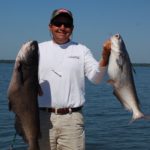
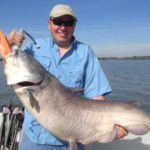
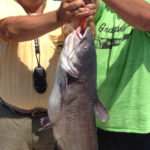
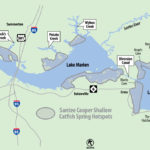




Be the first to comment